 Arlander, Annette. “Performing with the Weather.” Global Performance Studies, vol. 1, no. 2, 2018, https://doi.org/10.33303/gpsv1n2a5
Arlander, Annette. “Performing with the Weather.” Global Performance Studies, vol. 1, no. 2, 2018, https://doi.org/10.33303/gpsv1n2a5
Performing with the Weather
Annette Arlander
University of the Arts Helsinki
Considering the work of new materialists, especially, Karen Barad (2007), this paper discusses recording the shifting weather conditions during an ArsBioarctica residency at the biological station in Kilpisjärvi, in the high north, in the “thumb” of Finland in the spring of 2014. Performing for a video camera with Malla Fell by Lake Kilpis provides an example of working with the weather, with or without the human performer, with or without text, with regular intervals for a day and night and with real-time duration. These works are juxtaposed with some small attempts at performing in rain and snow in Falmouth, UK and in Stockholm, Sweden. Problems touched on include the entanglements of technology, the presence of the human figure, and the use of rough time-lapse technique or real time, with focus on the performing weather, like rain or snow. The melting ice that used to be a clichéd image of hope, of life returning after the long cold darkness, now resonates with the ominous overtones of dissolving glaciers and global warming. In this text, I will present some of the ideas of physicist and queer theorist Karen Barad in relation to this practice of performing landscape.[1]
Barad is especially interesting in the context of performance studies, since she proposes an understanding of how discursive practices are related to the material world. In her article, “Posthumanist Performativity: Toward an Understanding of How Matter Comes to Matter” (2003), and in her important work, Meeting the Universe Halfway (2007),[2] Barad critically reads and further develops Judith Butler’s theory of performativity, which she criticizes for a re-inscription of the nature-culture dualism, and for privileging discursive over material concerns (Barad 34-35). While performative accounts by social and political theorists focus on the productive nature of social practices, her agential realism acknowledges that the forces at work in the materialization of bodies are not only social, and the bodies produced are not all human (Barad 33-34). For Barad, discourse is not a synonym for language; meaning or intelligibility is not restricted to humans. She, consequently, refuses to separate discourse and materiality, and prefers to speak of material-discursive practices. “Discursive practices are the material conditions for making meaning […] [and] meaning is an ongoing performance of the world in its differential intelligibility” (Barad 335).
Barad emphasizes that practices of knowing and being are mutually implicated. For her, separating epistemology from ontology is a metaphysical assumption of an inherent difference between human and nonhuman, subject and object, mind and body, matter and discourse. Barad insists on an intertwining of ethics, knowing, and being. This is relevant for artists engaged in performance as research and artistic research, where an entanglement of researcher and what is researched is common. Her ideas present a challenge to account for the cuts of inclusion and exclusion we make, the apparatuses we use and are used by, as well as the marks on bodies they generate.[3] Barad’s focus on performativity has met some resistance, however, among theatre scholars. Rebecca Schneider, for instance, foregrounds the theatrical, and posits agential theatricality or becoming unreal to counter Barad’s agential realism (Schneider 14). The weather as a performance partner, although sometimes spectacular, is nevertheless decidedly real.
Performing at Lake Kilpis
Before discussing Barad’s ideas further, I will describe a few works created at the Helsinki University Biological Station by Lake Kilpis in the north of Finland, not far from the Norwegian border and the Polar Sea. I worked there for one week in April and another week in June 2014 as part of the ArsBioarctica Residency, organised by the Finnish Bio Art society.[4] For twelve years, I had performed landscape on Harakka Island, off Helsinki, through documenting the changes in the environment by returning to the same place repeatedly (Arlander, “Performing Landscape for Years”). In February 2014, this project was finished, and I wanted to try some of the same techniques — for instance, documenting a day and night with two-hour intervals — in a place I never visited before.
Kilpisjärvi, situated between Saana Fell and Lake Kilpis, near the Swedish and Norwegian border, is originally part of the land of the indigenous reindeer herding Sami people and something of a tourist destination today. In April, in brilliant spring light, on ice-covered Lake Kilpis, there is 150 cm of snow on the ground. The proximity of the Polar Sea makes the weather in the area extremely changeable, with clouds of rain and snow rolling in and disappearing again. The landscape shifted in character all the time, which was ideal for the type of recording I was planning to do; that is, performing for a camera on a tripod in the same place repeatedly, creating a rough form of time-lapse videos.
The first attempts were made on 3 April (2 pm – 8 pm) and 4 April (8 am – 10 pm). Wearing a dark blue scarf, I walked out on the ice, turning my back to the camera, and stood for a while looking at Malla Fell in front of me, returning there every two hours. This material was later compiled into the single channel video, Meeting Malla (10 min.), that, despite the slanting horizon, the jumps in my position between the takes and other mistakes, and partly because the camera chose to focus on the raindrops at the end, foregrounded a fascinating performance of the weather.
The “real” performance, a day rather than a day and night as planned, took place on 7 April (7 am – 9 pm) with clearer skies. The material was edited into two works: a two-channel installation, A Day with Malla 1-2 (8 min. 10 sec.), juxtaposes images with a human figure standing on the ice with the same images without a human presence. A single channel video, A Day with Malla (text) (4 min. 25 sec.), available attached to this text, below, includes a voice-over text in Finnish, written and recorded during my stay at the station, with subtitles in English. All of these works show a view of Lake Kilpis and Malla Fell, with the colours and shades of the landscape changing with the time of day and the shifting light and weather conditions.
When returning to Lake Kilpis in June, the spring had arrived; to recreate the image made in April, I found almost the same spot for my camera tripod, but the shores were open and there was no way I could walk on the ice. The slight shift in the angle of the camera transformed the image, so I had to abandon the idea. Rather, I stood on the shore with only part of the scarf on my shoulder visible in the image on 5 June (10 am to 10 pm) with two-hour intervals, and this material was edited into a single channel video, Looking at Malla (9 min. 20 sec.), with the scarf and the ice on the lake as the main actors.
To record the ice slowly moving on the lake in real time, I sat on a rock at the shore on 6 June around noon for approximately half an hour, and then recorded the same view without human presence. This material was edited using very long crossfades into a two-channel installation, Moment with Malla 1-2 (26 min. 10 sec.), where the human figure is slowly disappearing from one image, dissolving into the landscape, while slowly appearing in the other.
In summertime, there was plenty of light at night, so recording at day and night made sense. Sitting on the same rock on the shore every two hours, from 7 June at noon until 8 June at noon, I recorded the material for Day and Night with Malla 1-2 (30 min. 20 sec.), a two-channel installation that combines an image of me sitting on a rock looking at Malla with the same view without the human figure. Besides the movement of the melting ice and the water on the lake, the main action is provided by changes in weather and light conditions, with Malla almost hidden by the fog in the soft light of the arctic midnight.
Experiments in Rain
Fascinated by the dramatic effect of the raindrops blurring the landscape during my first visit to Kilpisjärvi, I decided to work with rain on some other occasions, despite humidity being detrimental to most cameras. Therefore, the drizzling rain in Falmouth in south-western England did not worry me while I was sitting on the rocks at the shore two years later, on Sunday morning 24th of July 2016, at the end of a seminar organised by the Rock/Body network at the nearby Penryn Campus in Cornwall.[5] Rather, I was curious to see how the camera would react. This time, however, I had a new camera, designed for still images, not fine-tuned to follow movement. Rather than clearly demarcated drops on the lens, the drizzle materialized as soft, white splotches and an increased soft whitening of the image. In the same manner as by Lake Kilpis, I recorded a session without the human figure as well. When seeing the material, I regretted not sitting in the rain for longer, since a more complete whiteout by the rain would have been fascinating; now, I could only hint at the possibility by fading to white rather than black at the end of an edited work, Body on the Rocks 1-2 (7 min. 11 sec.). Another version, edited of the same material, using long crossfades as in Moment with Malla, is called Body on the Rocks (mix) 1-2 (8 min. 15 sec.).
In the winter of 2016, as part of a project called Performing with Plants,[6] I was sitting in a small beech tree at Djurgården in Stockholm, curious to see if I could incite the weather to perform together with my camera again. Two out of several testing sessions were edited into separate videos: Sitting in the Beech — Snow (8 min. 20 sec.), recorded on 27 November 2016, and Sitting in the Beech — Rain (6 min. 50 sec.), recorded on 10 December 2016. In both cases, the raindrops and snowflakes are visible in the wind, but they are not hitting the lens; at least, their action is not visible as white splotches like in Falmouth. After the session in November, returning to the camera, I found the lens partly covered in snow, surprised to see the camera still working and anticipated an interesting image divided in half. The camera had, nevertheless, managed to compensate, to see through the snow cover to such a degree that the only effect visible in the image was a gradual softening, the image slowly turning more and more grey. The camera had stuck to the original assignment, and did not adjust its focus to follow the movement of the snow. In the December session, the raindrops did not influence the image at all, perhaps due to the direction of the wind.
These examples of my attempts at performing with the landscape, letting the landscape perform, or perhaps recording the weather performing the landscape, differ in their approach to time. All works performed in Kilpisjärvi, except Moment with Malla, are using a rough time-lapse technique, recording the same view with two-hour intervals, and thus showing the changes produced by the weather. The images in Falmouth and Stockholm are made as singular sessions, showing the weather performing in real time with fewer changes, resembling still images. The relationship between the landscape and the human figure differs as well. The open view of Lake Kilpis and Malla Fell with a tiny human figure is an example of fairly traditional landscape imagery based on the legacy of romantic landscape painting. The rocks in Falmouth and, especially, the tree in Stockholm, of which only a small part is visible, together with a larger human figure, are not landscapes in the same sense, and challenge conventional ideas of how to depict the environment. In all three approaches, the rain is the main actor and collaborator, although visible in various ways — as the white blurred spots appearing on the lens, as the movement of drops in the wind passing the lens, or as the invisible snow curtain functioning as a dimmer. In all of the works, the rough sound recorded by the camera microphone without wind protection is used as such; the noise produced by the wind hitting the microphone heightens the awareness of technological mediation.
This type of playing with the technology, the weather, the landscape, and the human observer-performer, an approach inviting chance occurrences, like “let’s see what it is going to do this time,” presumes a rather naïve relationship to technology. It is the opposite of a professional attitude, with the master of the art using technology as a tool to construct the desired result in the harshest of circumstances. Although, in this case, we should perhaps not speak of chance but, rather, reactions of the technology, pre-programmed based on assumptions of average circumstances.
By Way of Context
“[A]ll artistic practice that successfully foregrounds body-environment interactions is always already ecological,” Bruce McConachie writes (93). “The experience of art is just as real as other experiences in the material world and all experiences have consequences” (McConachie 98). Rather than focusing on the importance of the live event, as one would expect from a theatre scholar, he adds: “By rearranging the materiality of our minds, performances in all media can exert performative pressure on our conceptions of social roles, governmental policies, and ecological realities” (McConachie 98).
In film, slowness and static images of long duration have been considered the hallmarks of eco-cinema. Scott MacDonald suggests that eco-cinema provides an experience of nature that functions as a model for “patience and mindfulness”, modes of awareness that are needed for an “appreciation of […] the natural environment”, and offers “new kinds of film experience” as an alternative to conventional modes of watching media, thus helping to foster a more “environmentally progressive mindset” (MacDonald 19-20, emphasis in the original).
Within contemporary art, weather, like almost anything else, has been treated as a medium (Randerson et al. 2015), and art installations with or about weather abound (Bower 2012). The approach within theatre and performance extends from dramatic (dis)plays of climate change (Chaudhuri 2012), via eco-activist performance actions (Standing 2012), to growing organic food in “a combination of Brechtian aesthetic and ecological socialism” (Davis 74). Within dance, Paula Kramer has recently described working outdoors in terms of physical exposure (Kramer 2016). As performances for camera, Eeo Stubblefield’s Still Dance with Anna Halprin could serve as a predecessor to these experiments, although there are perhaps more differences than similarities: using video rather than still images, the same person functioning behind and in front of the camera, and, most importantly, a less intimate and spectacular relationship between the body and the land (See Thomas 2012). The performing body is not naked or soaked in mud in my examples, but stands on the ice or sits on a rock or in a tree in a relatively everyday manner. Moreover, instead of “nature” I prefer thinking of “natureculture” or the environment.
Organism and Environment
Problematizing our relationship to the environment, rather than the weather as such, was one of my key concerns, especially at Lake Kilpis; but the idea of environment is, in itself, problematic in many ways. What is environment and for whom?
Gregory Bateson, famous for articulating the formula “the unit of survival is organism + environment,” explains in his Steps Towards an Ecology of Mind (1972): “Formally we thought of a hierarchy of taxa — individual, family line, subspecies, species etc. — as units of survival. We now see a different hierarchy of units — gene-in organism, organism-in-environment, ecosystems, etc. Ecology, in the widest sense, turns out to be the study of the interaction and survival of ideas and programs (i.e. differences, complexes of differences, etc.) in circuits” (Bateson 149). Theatre scholar Baz Kershaw sums up Bateson’s idea: “Utterly key to this account of systemic ‘thinking’ is that it does not make sense to separate ‘organisms’ from ‘environments’ as they are aspects of the same system. [Following Bateson] ‘What thinks is the total system which engages in trial and error […]. The unit of survival is organism plus environment.’ […] Hence the meta-system of sustaining life on Earth is an ‘ecology of mind’” (Kershaw 248).
In The Three Ecologies (1989), Felix Guattari reminds us of the mental and the social ecologies, in addition to the environmental one, and insists that all three need to be considered together, and as interconnected. “The three ecologies originate from a common ethico-aesthetic discipline”, he adds, but are “distinct from the point of view of the practices that characterize them. Their different styles are produced by” what he calls “heterogenesis, in other words, processes of continuous resingularization” (Guattari 68-69, emphasis in original). He further develops Bateson’s idea of organism plus environment (or action plus context) by insisting, that “a praxis […] is established in the rupture of the systemic ‘pretext’” (Guattari 54). An action can transform its context.
In Barad’s thinking, the idea of separating organism and environment is challenged. In an interview in 2012, Barad refers to studies with colonies of slime mold and exclaims: “How can we expect the notion of an organism understood as an individual that is situated in a container we call the environment to begin to speak to the complexity of the intra-active reconfiguring of bodily boundaries that defines the slime mold’s astonishing material existence?” (Barad, “Intra-actions” 77).
Barad emphasizes the rejection of “particularism,” the idea that the world consists of individuals with properties. For her, there exist no predetermined subjects and objects that could interact, form networks or assemblages. Here, she differs from so-called object-oriented ontologists (OOO),[7] although some attempts to find connections between OOO and new materialism have been made (Bennett 2015). For Barad, the primary units are phenomena rather than objects, “phenomena are ontological entanglements”; phenomena are not only what is observed in laboratories, they are “the basic units of existence” (Barad 333, emphasis in original). While the primary ontological units are phenomena, that is, dynamic topological reconfigurings or entanglements or relationalities or (re)articulations of the world, the primary semantic units are material-discursive practices, through which both ontic and semantic boundaries are constituted. This dynamism is for her agency; it is not an attribute, something somebody has, but “the ongoing reconfigurings of the world” (Barad 141). Accordingly, we can assume that what is organism and what is environment is continuously reconfigured. In digesting food, or in the basic acts of breathing or standing in the rain, this negotiation becomes palpable on a human level. What is part of the image and what is not, who or what is performing, and who or what forms the environment for the performance, is, likewise, rearticulated through various material-discursive practices.
Intra-actions and Agential Cuts
For Barad, knowing is not the exclusive birthright of humans; it is “not a play of ideas within the mind of a Cartesian subject that stands outside the physical world”; rather, “knowing is a physical practice of engagement” (Barad 342). This sounds familiar to artist-researchers and performance studies scholars; writers as diverse as Conquergood (1999), Bolt (2004), Riley and Hunter (2009), Johnson (2011), and Spatz (2015) have emphasized knowing as a physical practice. For Barad, the physical practice of knowing includes the larger material arrangement, where “a specific engagement of the world becomes differentially intelligible to another part of the world in its differential accountability” (Barad 342). For her, “scientific practices are specific forms of engagement that make specific phenomena manifest” (Barad 336). Likewise, artistic practices can be understood as specific forms of engagement that make specific phenomena manifest.
Apparatuses produce the phenomena they measure, Barad explains, which is not to say that reality is produced by human concepts; rather, concepts are specific material arrangements (Barad 334). The boundaries and properties of the parts of a phenomenon become determinate only in the enactment of an agential cut that delineates the “measured object” from the “measuring agent.” And this is not restricted to human activities. A measurement is the intra-active marking of one part of a phenomenon by another; nothing in a measurement makes it necessarily human-centred (Barad 338). “Intra-action” is a term coined by Barad to replace the usual term “inter-action,” which presumes that the interacting parts pre-exist the action.[8] Intra-action “signifies the mutual constitution of entangled agencies” (Barad 33, emphasis in original). According to her, “distinct agencies do not precede, but rather emerge through, their intra-action” and, importantly, “agencies are only distinct in relation to their mutual entanglement; they don’t exist as individual elements” (Barad 33, emphasis in original).
To put it simply, differences are made, not found, and dichotomies derive from particular cuts (Barad, “Intra-actions” 77). “Intra-actions include the larger material arrangement (i.e., a set of material practices) that effect an agential cut between ‘subject’ and ‘object’ (in contrast to the more familiar Cartesian cut which takes this distinction for granted)” (Barad 139-140). Barad is re-interpreting the thinking of physicist Niels Bohr and developing his ontology beyond his humanist bias. What is required for objectivity, according to Bohr, is an unambiguous and reproducible account of marks on bodies. For Barad, following Bohr, “observer” and “observed” are merely two physical systems intra-acting in the marking of the “effect” by the “cause.” Human observers are possible, but not necessary, and objectivity is a matter of “accountability to marks on bodies” (Barad 326).
What is crucial for Barad is the accountability to marks on bodies, which requires an accounting of the apparatuses that enact determinate causal structures, boundaries, properties, and meanings (Barad 340). She stresses the importance of “the proper accounting of agential cuts within the specific phenomenon in question” (Barad 345, emphasis in original). Although there are no determinate pre-existing entities with determinate properties, there are determinate marks on bodies produced through specific intra-actions, and these need to be accounted for. How do we account for the apparatuses we use or are used by? And for the marks on bodies they create?
Working with the Weather
In the practice of performing for camera, described above, the framing enacts an agential cut of sorts in the image of the environment. The camera as the “measuring apparatus” produces an image by creating a split between what is within and what is outside the frame, between what is part of the image and what is not. This division does not pre-exist in the landscape; the framing is produced by the act of video recording. This intra-action between equipment and environment involves material-discursive practices like the properties of the lens of the camera or my preconceptions of what constitutes a good composition, potential landmarks provided by the terrain or the condition of the ice on the lake, and so on. What is apparatus and what is phenomenon, what is “measuring agent” and what is “measured object,” what is equipment and what is environment, is not given but articulated in each case.
Who or what performs the observer as part of the “measuring apparatus” (behind the camera), and who or what performs the observed, the object, or “causal agency” to be “measured” (in front of the camera), can differ from case to case. By using a camera on a tripod, the artist can act in both roles, in turn, and split into a performer in front of the camera and a witness behind it. The division of labour is not predetermined but contingent to the situation. With the help of technology, the same person can act as photographer and model, put the camera to record and to function as a witness, and then enter the image, engage in the action, and finally return behind the camera to control the result. This apparatus enables a practice less dependent on funding, planning, and so-called production values.
The choice of time schedule or temporal framing forms another kind of apparatus, or measuring agency. By repeating the same action every two hours, picking “slices of time” of the landscape in Kilpisjärvi, a series of literal cuts take place. Everything between the recorded moments is excluded from the video. Another temporal framing or measuring apparatus, like performing every three hours, or only once, as in Falmouth or Stockholm, produces another interpretation of the weather and the changes in the environment. This is obvious when comparing, for instance, Day and Night with Malla, performed and recorded every two-hours for a day and night, and Moment with Malla, performed and recorded in one sequence on the same rock, with the same framing of the image. The changes in the weather are foregrounded in the time-lapse videos, while the actual experience of the wind or rain is more palpable in the videos based on one take like Sitting in the Beech — Rain and Sitting in the Beech — Snow.
Another type of measuring agency is at work in the editing process. By removing, rather than adding material, leaving out the part where I enter and exit the image, an appearance of continuity is produced, either a rough form of time-lapse or a still-image like illusion of seemingly infinite duration.
This process of performing for camera together with the weather involves human decision-making, of course, although using the automatic functions of the video camera means that technology has the lead. The light meter and white-balance calculator, automatic focus, and other technological devices included in the functions of the camera constantly react and readjust to changes in the environment. The time of day, the angle of light, temperature, humidity and wind, clouds, passers-by of all species, and the movements of the performer intra-actively produce these changes. At the end of the video Meeting Malla, the automatic focus of the camera chooses the raindrops hitting the lens to focus on instead of the landscape behind them, which is thus hidden from view. This happened unbeknownst to me while I was standing on the lake, as an intra-action of camera and weather, of environment and technology. When trying to stimulate a similar reaction with another camera in the soft drizzle in Falmouth, the intra-action produced diffuse, white splotches. The editing process, too, is interplay between human choices, recorded environmental circumstances, and the affordances of technology.
All these details of the working method, like using a camera on tripod in order to be able to act as performer and witness, framing the image related to landmarks in the environment, using the microphone of the camera without wind protection, choosing the time, the duration and schedule of performing and recording, as well as the principles used in the editing, function as “measuring agents” and produce agential cuts in the “measured object,” the environment. They make a difference for the final videos by defining what is included and what is excluded. In the words of Barad: “Since different agential cuts materialize different phenomena — different marks on bodies — our intra-actions […] contribute to the differential mattering of the world” (Barad 178). Importantly, these cuts are not only a matter of choice. Cuts are not enacted “by willful individuals”, Barad points out, but “by the larger material arrangement” of which they are a part. We are responsible for the cuts that we help to enact, not because we choose or are being chosen “but because we are an agential part of the material becoming of the universe”, she claims (Barad 178). Although I choose the apparatus, the framing, and the moment, the environmental circumstances that the camera intra-acts with produce the image.
Agency Everywhere
For Barad, agency is distributed over nonhuman as well as human forms (Barad 214). This distributed agency is evident in my examples as well. On Lake Kilpis, the ice, the rock, the scarf, the wind, the clouds, the snow, the sun, birds and humans, barking dogs, snow scooters, passing cars, Malla Fell, the sudden fog, and the empty beer can that appears from nowhere floating next to the rock are all entangled phenomena and part of the material becoming of the world in the image. The invisible elements, like the camera, the tripod, the pieces of wood on the shore marking the place of the tripod, the Biological Station at which I stayed, the ArsBioarctica residency enabling my stay, and all other phenomena and material-discursive practices indirectly impacting the image have agency, too. In Falmouth and Stockholm, agency is distributed in a different, although related, manner. In the video imagery, the boundaries between what or who seems to perform can shift; the scarf can turn into the main actor, as in Looking at Malla. Or, the raindrops can assume centre stage, as in Meeting Malla. In Sitting in the Beech — Rain, the thick, wet branches of the tree are the main performers. In terms of agency, in creating the image, we all have our part in the intra-action.
The ice melting on the lake, the rock on the shore, and the water moving between them are co-constituted and entangled in a way that changes over long periods of time. The rock and the human being sitting on the rock are co-constituted and entangled as well, consisting of the same minerals, albeit living on a different time scale, with the cold wearing and tearing the surface of both. The tree and the human have a common cellular ancestor, and share much of their way of dealing with energy. For Barad, however, it is not enough to incorporate “both humans and non-humans into the apparatus of bodily production”; she insists that “humans do not merely assemble different apparatuses” for their “knowledge projects; they themselves are part of the on-going reconfiguring of the world” (Barad 171). She dismisses both humanist and anti-humanist accounts; “human subjects do not exist prior to their ‘involvement’ in natural-cultural practices”, nor are they “the effects of human-based discursive practices” (Barad 171). For her, “human bodies, like all other bodies, are not entities with inherent boundaries and properties but phenomena that acquire specific boundaries and properties through the open-ended dynamics of intra-activity” (Barad 172).
In terms of this material-discursive and natural-cultural practice of performing landscape, that would mean that I acquire specific boundaries and properties through the actions involved. The environment changes through my actions, when I create a path in the snow, and the environment changes me, when I get a cold by standing in the wind. Moreover, it means that ideas of what is a beautiful view or a liveable environment change over time, and that we all are transformed by and together with the environment and the weather, which we transform by our actions. The video artworks, which can be shown in other places at other times, have their agency, too, and could potentially change the way the viewers imagine that specific place, the north in general, or the warming of the climate in the arctic region. When Looking at Malla was shown in Mediaboxi, Gallery Forum Box in March 2015 in Helsinki, I realized how the associations related to images of ice melting on a lake have changed in recent years. An image of hope, melting ice, spring finally returning after a long winter even to the high north, now has ominous overtones of melting glaciers and rising sea levels due to climate change.
According to Barad, we are responsible to others we are entangled with through the various ontological entanglements that materiality entails. What is on the other side of the agential cut is not separate from us. “Differentiating is not about radical exteriorities”, it is “not about Othering, separating, but on the contrary, about making connections and commitments” (Barad, “Matter Feels…” 69). Ethics is not about the right response to a radically exteriorized other; it is about responsibility and accountability for the relationalities of which we are a part (Barad 393). These relationalities are too numerous to keep count of in most cases. This is evident when thinking of the connections involved in these few examples, which are not limited to my visiting Sami country without engaging in the debate on land rights, for instance; but, rather, recording moments in the life of Lake Kilpis and Malla Fell, or sitting on the shore in Falmouth without inquiring about local matters of concern, or in the beech in Stockholm oblivious of its specific history. The relations include all the connections the resulting artworks might engender. Performances for camera distributed in digital form can be endlessly copied, but also destroyed with one click of a mouse. They are seemingly “immaterial” and light, although heavily dependent on technology and electricity; they could easily dissolve into the general flow of disposable media images but could, in principle, be watched hundreds of years from now as strange souvenirs from a distant past. The entanglements involved are too numerous to even imagine, much less to account for and articulate. To take one key player, the weather — as a phenomenon it is entangled with numerous material-discursive practices of which these performances form only a minuscule example. How could I account for all the relationalities involved? And still, that should be done, somehow.
So What?
“All bodies, including but not limited to human bodies, come to matter through the world’s iterative intra-activity, its performativity,” Barad writes (“Matter feels…” 69). Her insistence on taking both human and nonhuman bodies and their mutual entanglement into consideration is a challenge for performance as research and performance studies, which, like performing arts in general, tends to regard human bodies as the interesting ones. Barad radicalises the idea of performativity, and makes it material in a way that is crucial today. Her ideas can be interpreted as a challenge to account for the cuts of inclusion and exclusion we make, the apparatuses we use and are used by, as well as the marks on bodies generated by them. As my attempt here has made explicit, it is easier said than done. The notions of intra-action and agential cut have aided me in describing some examples of performing landscape and the entanglement of environment and technology involved. Besides witnessing my performing for camera together with the weather, these works were recording the weather performing the landscape at these specific times in these specific places, and were, thus, in their manner, participating in the performativity of the world.
(Thanks to the Bio Art Society for the possibility to spend time at the ArsBioarctica residency in Kilpisjärvi.)
Performing with the Weather (excerpts from video works) 3 min. 50 sec.
A Day with Malla (text) video 4 min 25 sec

Performing with the Weather:
Two visits to Kilpisjärvi and other performances for camera

First visit to Kilpisjärvi in April 2014
• Meeting Malla 2014 HD 10 min.
(performed April 3, 2 pm – 8 pm and April 4, 8 am – 10 pm, with two-hour intervals)

Meeting Malla, video still 1

Meeting Malla, video still 2

Meeting Malla, video still 3

Meeting Malla, video still 4

Meeting Malla, video still 5

Meeting Malla, video still 6

Meeting Malla, video still 7

Meeting Malla, video still 8

Meeting Malla, video still 9

Meeting Malla, video still 10

Meeting Malla, video still 11

Meeting Malla, video still 12

Meeting Malla, video still 13

First visit to Kilpisjärvi in April 2014
• A Day with Malla 1-2, 2014 HD 8 min. 10 sec.
(performed 7 April 2014 between 7 am and 9 pm, with two-hour intervals)
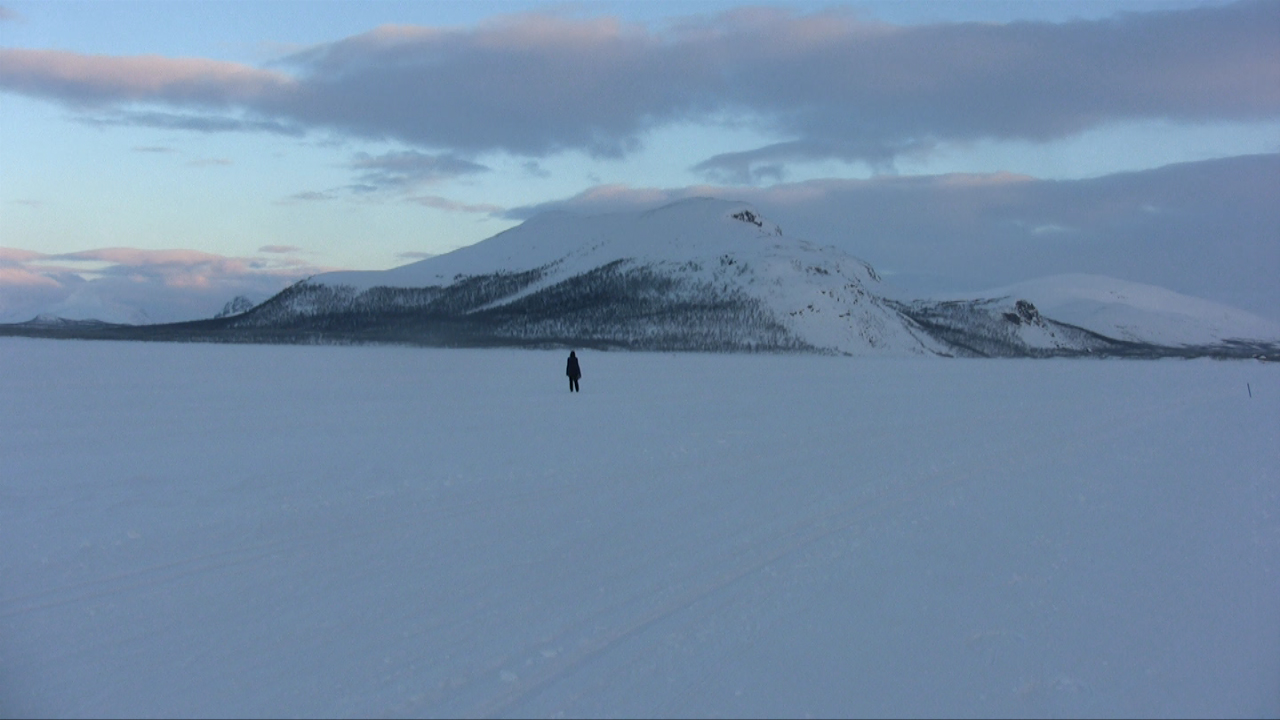
A Day with Malla 1, video still 1

A Day with Malla 1, video still 2

A Day with Malla 1, video still 3

A Day with Malla 1, video still 4

A Day with Malla 1, video still 5

A Day with Malla 1, video still 6

A Day with Malla 1, video still 7

A Day with Malla 1, video still 8

A Day with Malla 2, video still 1

A Day with Malla 2, video still 2

A Day with Malla 2, video still 3

A Day with Malla 2, video still 4

A Day with Malla 2, video still 5

A Day with Malla 2, video still 6

A Day with Malla 2, video still 7
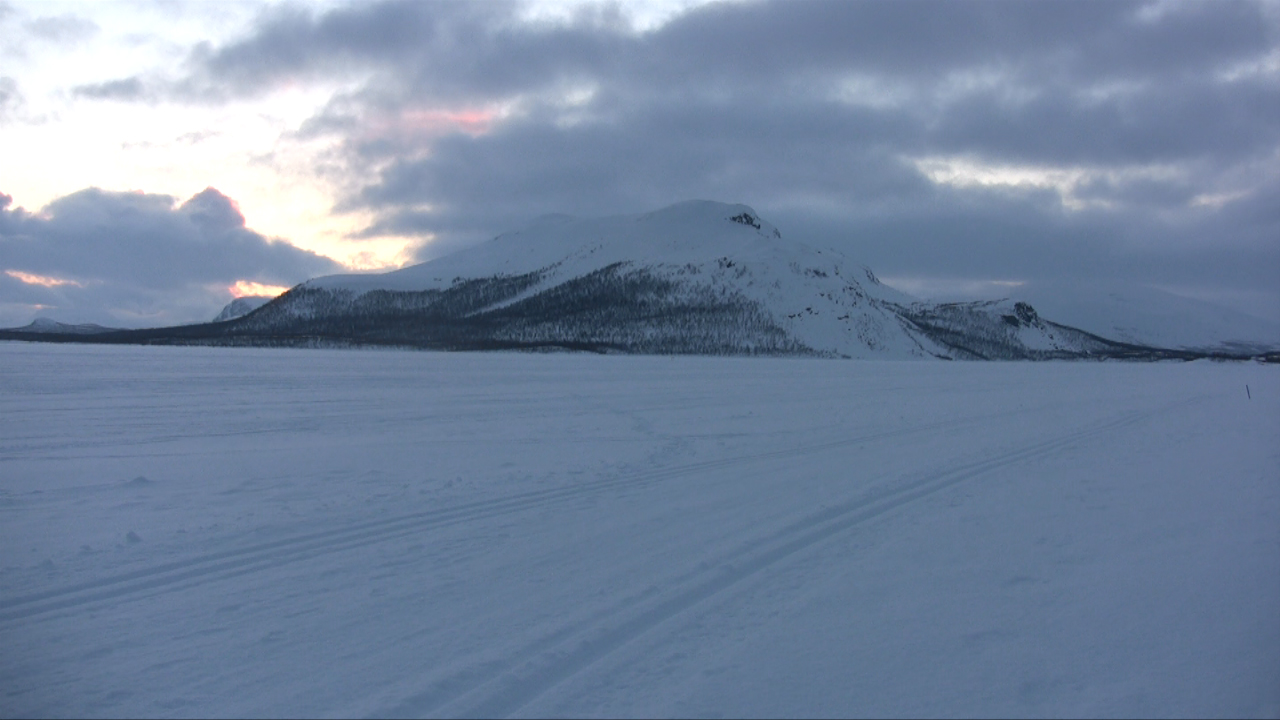
A Day with Malla 2, video still 8

First visit to Kilpisjärvi in April 2014
• A Day with Malla (text) 2014 HD video 4 min 25 sec.
(text added to material performed 7 April 2014 between 7 am and 9 pm, with two-hour intervals)

A Day with Malla (text), video still 1
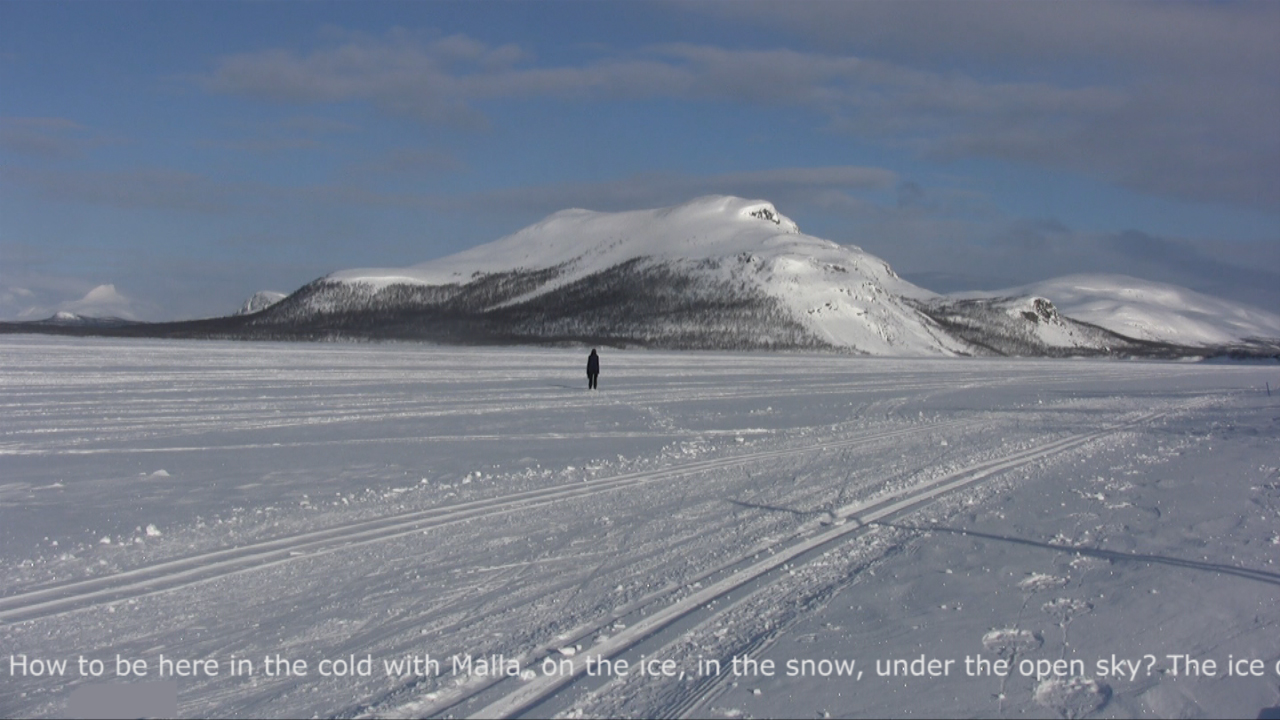
A Day with Malla (text), video still 2

A Day with Malla (text), video still 3
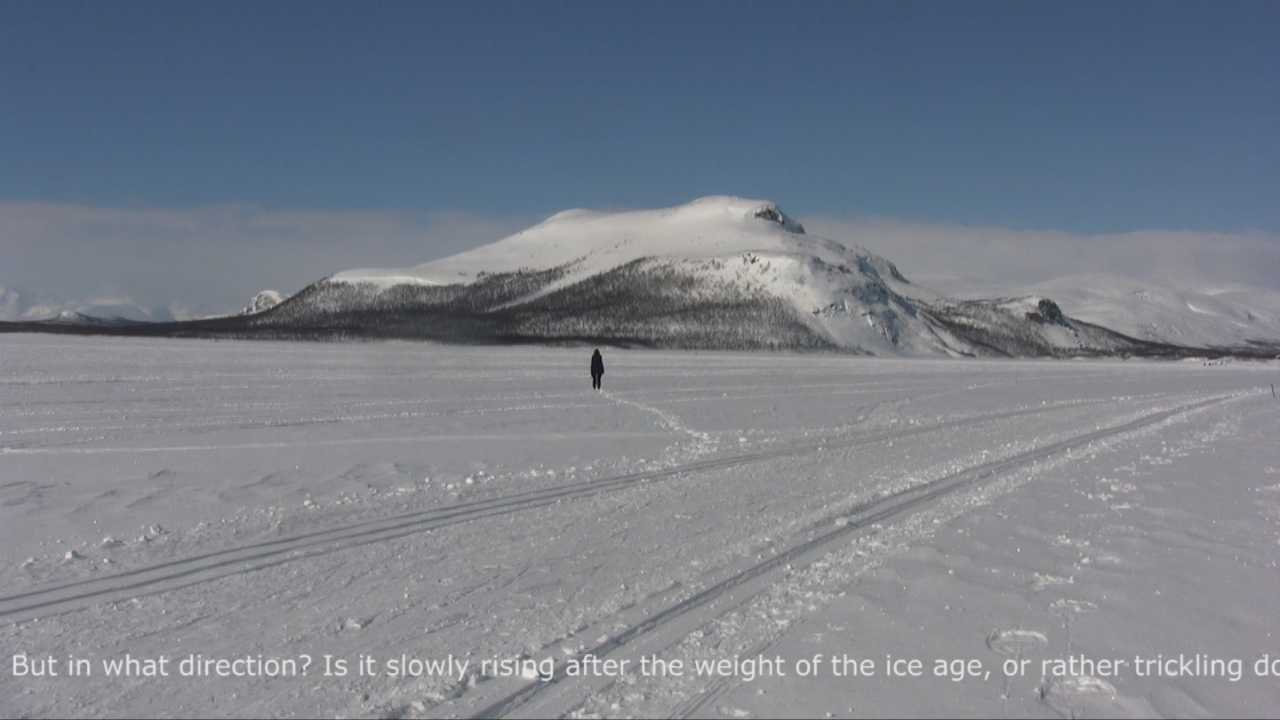
A Day with Malla (text), video still 4

A Day with Malla (text), video still 5

A Day with Malla (text), video still 6

A Day with Malla (text), video still 7
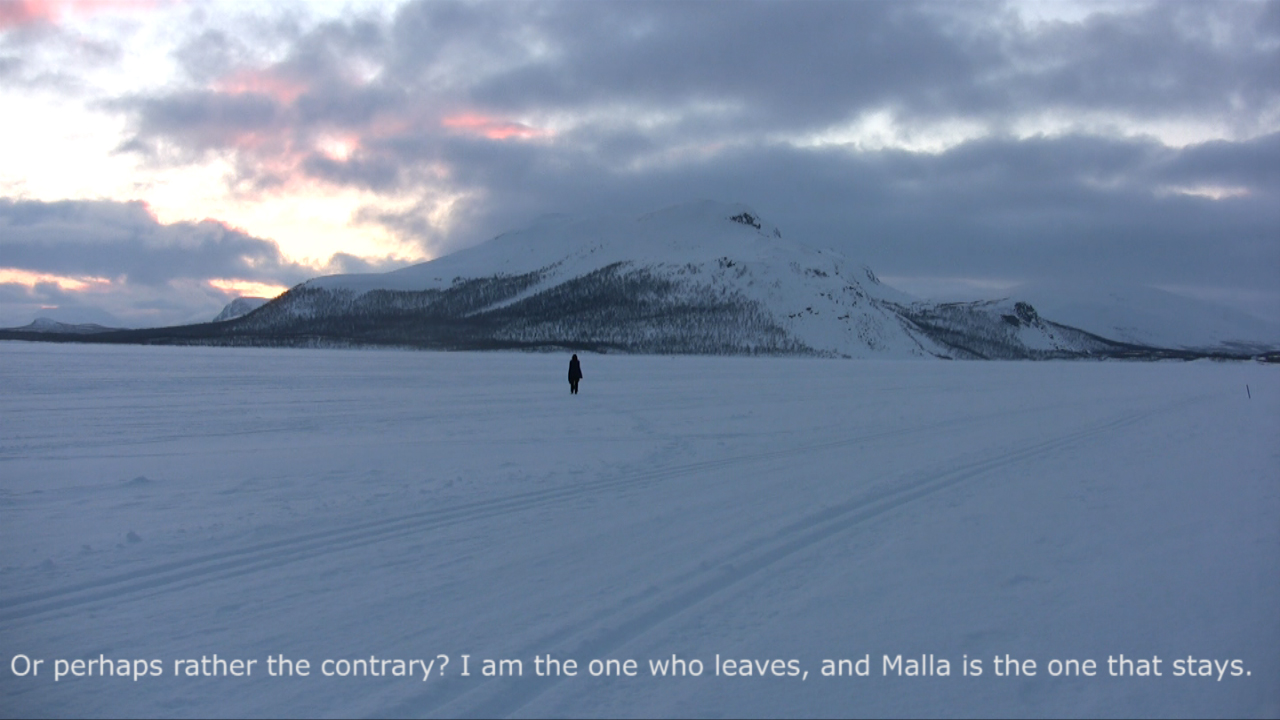
A Day with Malla (text), video still 8

Second visit to Kilpisjärvi in June 2014
• Day and Night with Malla 1-2, 2014 HD 30 min 20 sec.
(performed between noon June 7 and noon June 8 2014, with two hour intervals)

Day and Night with Malla 1, video still 1
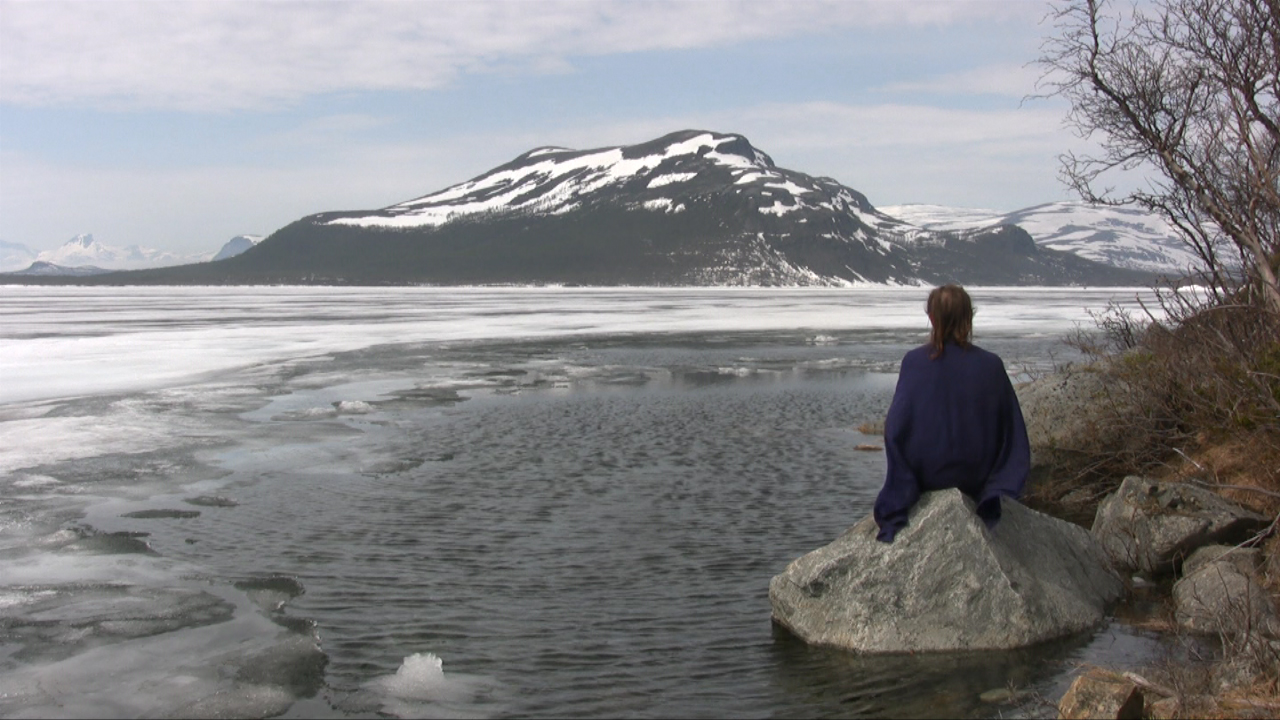
Day and Night with Malla 1, video still 2

Day and Night with Malla 1, video still 3

Day and Night with Malla 1, video still 4

Day and Night with Malla 1, video still 5

Day and Night with Malla 1, video still 6

Day and Night with Malla 1, video still 7
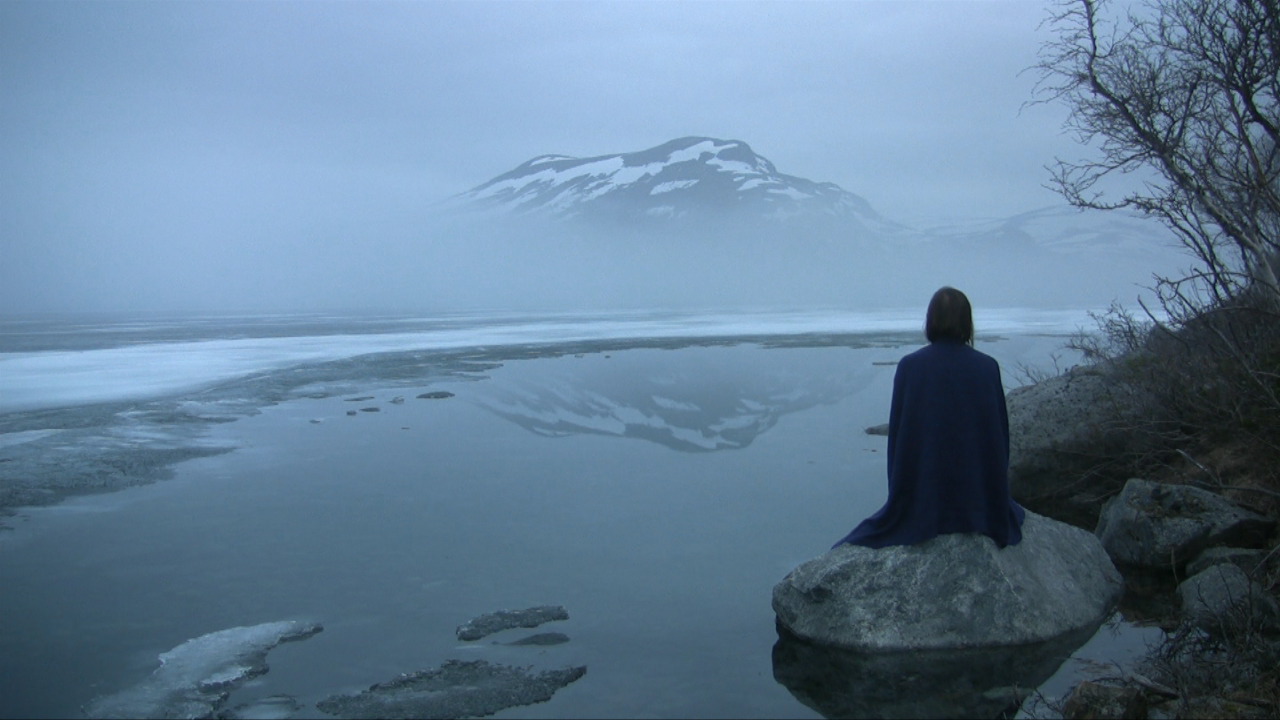
Day and Night with Malla 1, video still 8

Day and Night with Malla 1, video still 9

Day and Night with Malla 1, video still 10

Day and Night with Malla 1, video still 11

Day and Night with Malla 1, video still 12

Day and Night with Malla 1, video still 13

Day and Night with Malla 2, video still 1

Day and Night with Malla 2, video still 2

Day and Night with Malla 2, video still 3

Day and Night with Malla 2, video still 4

Day and Night with Malla 2, video still 5

Day and Night with Malla 2, video still 6

Day and Night with Malla 2, video still 7

Day and Night with Malla 2, video still 8
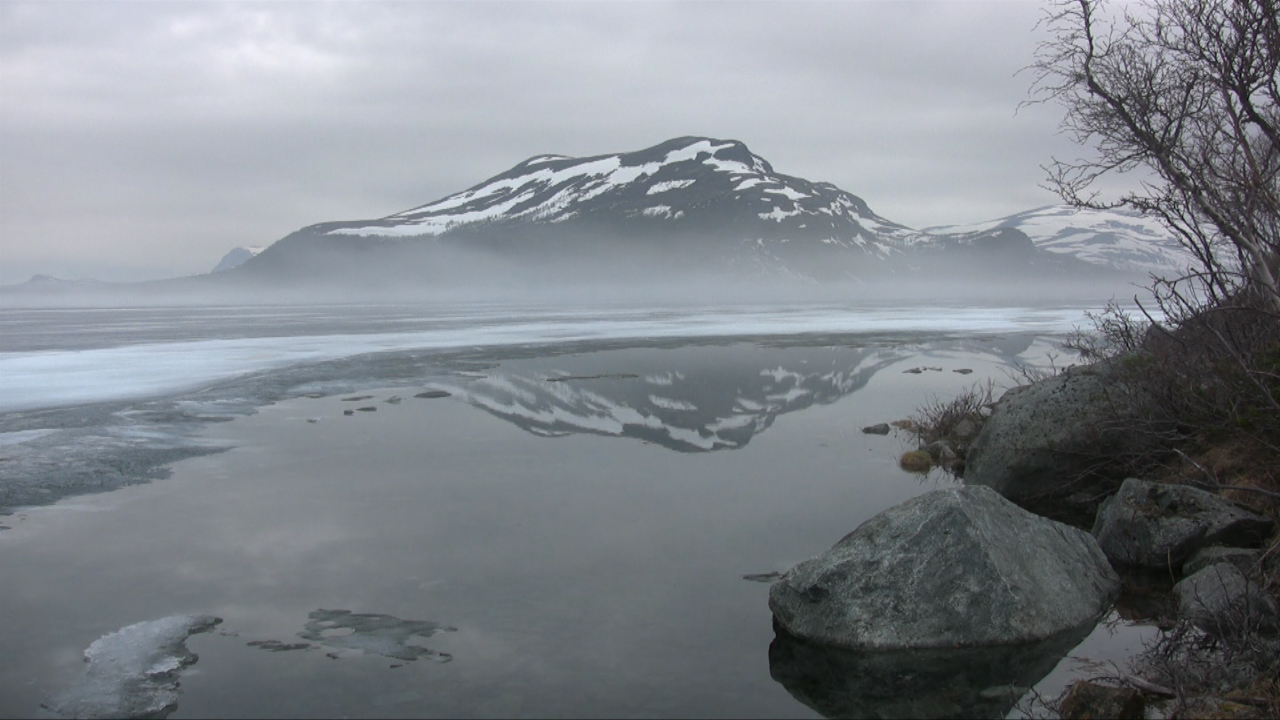
Day and Night with Malla 2, video still 9

Day and Night with Malla 2, video still 10

Day and Night with Malla 2, video still 11

Day and Night with Malla 2, video still 12

Day and Night with Malla 2, video still 13

Second visit to Kilpisjärvi in June 2014
• Moment with Malla 1-2, 2014 HD 26 min 10 sec. (performed on June 6 2014)

Moment with Malla 1, video still 1

Moment with Malla 1, video still 2

Moment with Malla 2, video still 1
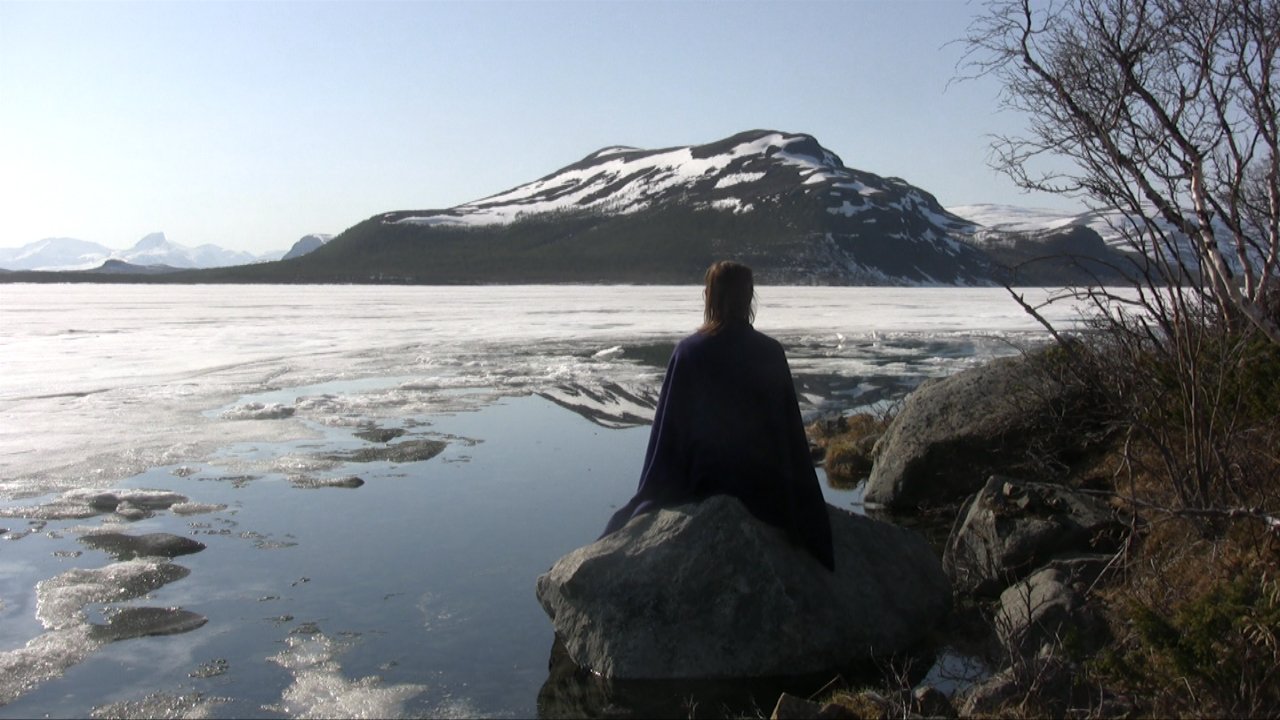
Moment with Malla 2, video still 2

Second visit to Kilpisjärvi in June 2014
• Looking at Malla 2014 HD 9 min. 20 sec.
(performed on June 5 2014, between 10 am - 10 pm with two-hour intervals)

Looking at Malla, video still 1

Looking at Malla, video still 2

Looking at Malla, video still 3

Looking at Malla, video still 4

Looking at Malla, video still 5
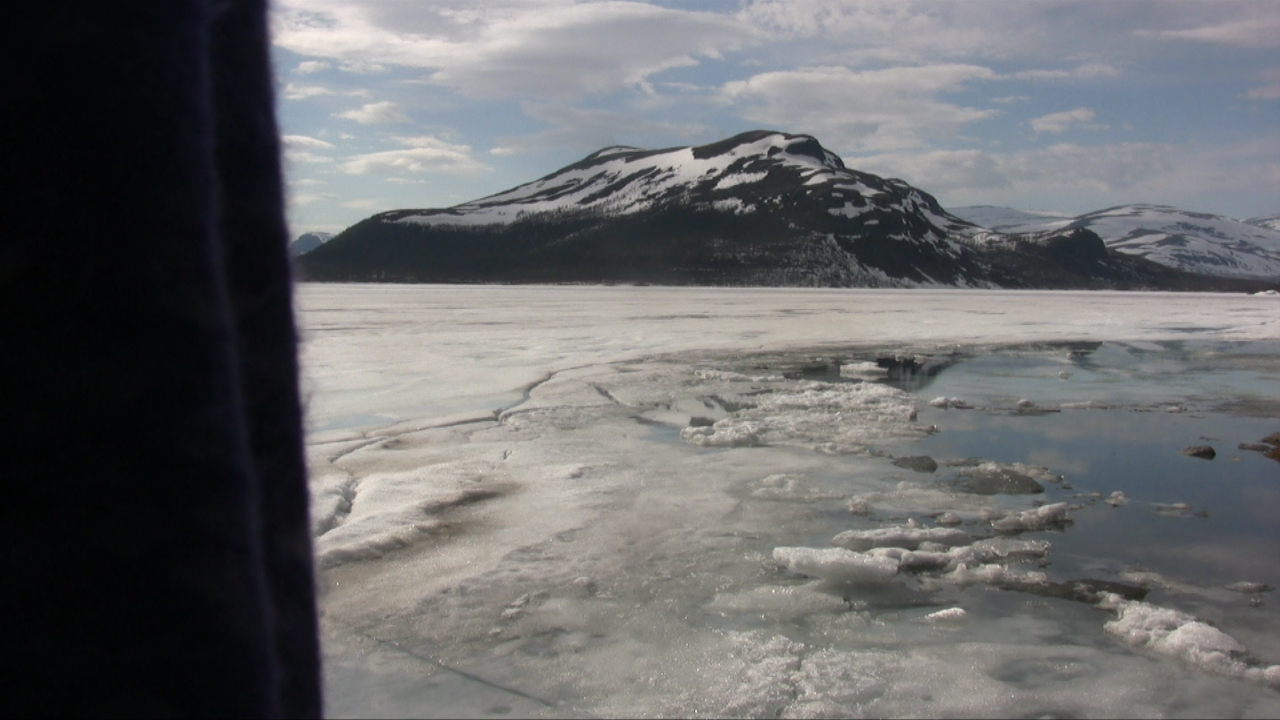
Looking at Malla, video still 6

Looking at Malla, video still 7

Looking at Malla, video still 8

Other experiments
• Body on the Rocks 2016 HD 7 min. 11 sec.
(performed on July 24 2016, on the shore in Falmouth, UK, around 11 am)

Body on the Rocks 1, video still 1

Body on the Rocks 1, video still 2

Body on the Rocks 2, video still 1

Other experiments
• Sitting in the Beech – Snow 2017 HD 8 min. 20 sec.
(performed on November 27 2016, in a tree on the shore of Djurgården in Stockholm, Sweden, around 3 pm)

Sitting in the Beech – Snow, video still 1

Sitting in the Beech – Snow, video still 2
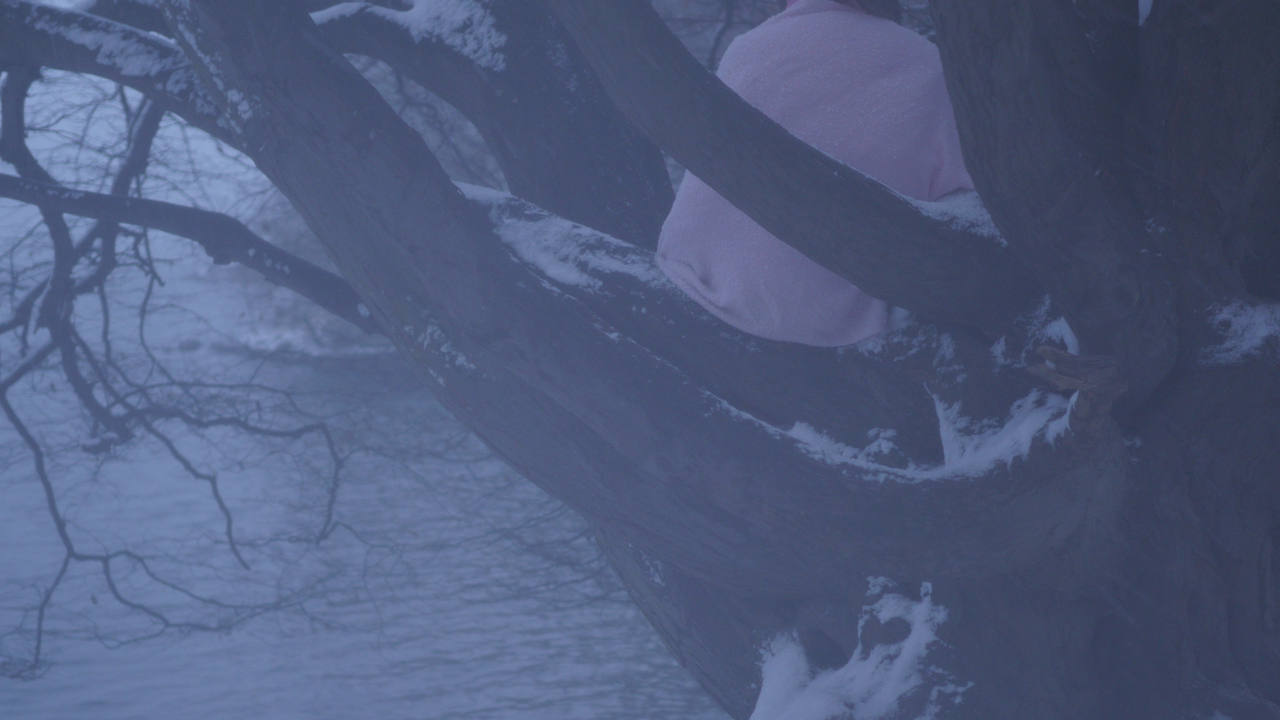
Sitting in the Beech – Snow, video still 3

Other experiments
• Sitting in the Beech – Rain 2017 HD 6 min. 50 sec.
(performed on December 10 2016, in a tree on the shore of Djurgården in Stockholm around 3 pm)
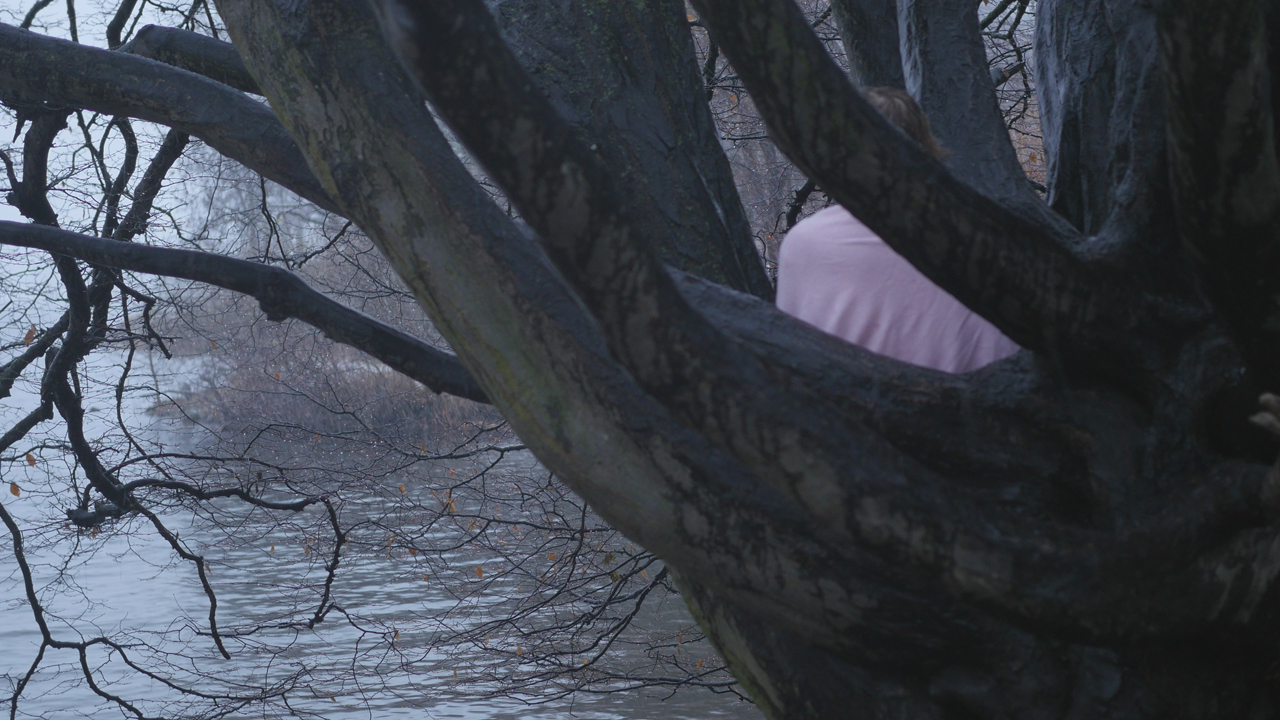
Sitting in the Beech – Rain, video still 1

Sitting in the Beech – Rain, video still 2

© Arlander 2017
Performing with the Weather Slides
Notes
[1] This text is partly based on a paper, “Working with the Weather,” presented at Performance Studies international #22 in Melbourne on 6 July 2016.
[2] Meeting the Universe Halfway is the work by Barad referred to, unless otherwise indicated.
[3] I discuss Barad’s ideas more in detail in “Agential Cuts and Performance as Research.”
[4] I have described my visits more in detail in “Data, Material, Remains”. Blogposts, photos, and the final video works as smaller files, available in the Research Catalogue in an exposition called ArsBioarctica Residency 2014 at https://www.researchcatalogue.net/view/266988/266989.
[5] Rock/Body: Performative Interfaces Between the Geologic and the Body was an AHRC-funded network led by Dr. João Florêncio and professor Nigel Clark. See website http://rockbody.exeter.ac.uk.
[6] Performing with Plants is an artistic research project, which I began in 2017 at the Helsinki Collegium for Advanced Studies. More information visit the website https://www.researchcatalogue.net/view/316550/316551.
[7] For an overview of object-oriented ontology, see O-zone / A Journal of Object-oriented Studies at http://o-zone-journal.org.
[8] For an attempt at understanding the notion of intra-action with regard to performing landscape, see Arlander “From Interaction to Intra-action in Performing Landscape” at http://www.raco.cat/index.php/Artnodes/article/viewFile/303309/392962.
Works Cited
Arlander, Annette. “Agential Cuts and Performance as Research.” Performance as Research: Knowledge, Methods, Impact, Edited by Annette Arlander, Bruce Barton, Melanie Dreyer-Lude, and Ben Spatz, Routledge, 2018, 133- 151.
———. “Data, Material, Remains.” Disrupting Data in Qualitative Inquiry: Entanglements with the Post-Critical and Post-Anthropocentric, Edited by Mirka Koro-Ljungberg, Teija Löytönen, and Mark Tesar, Peter Lang Publishing, 2017, 171-182.
———. “From Interaction to Intra-action in Performing Landscape.” Artnodes. 14 (2014), 26-34. http://www.raco.cat/index.php/Artnodes/article/viewFile/303309/392962. Accessed 15 December 2017.
———. “Performing Landscape for Years.” Performance Research. 9:3 (2014), 27-31.
———. “Performing with Plants (Artistic Research Project).” Research Catalogue. “https://www.researchcatalogue.net/view/316550/316551 . Accessed September 2017.
Barad, Karen. “‘Intra-actions’ (Interview of Karen Barad by Adam Kleinmann).” Mousse Magazine. 34 (2012), 76-81.
———. Meeting the Universe Halfway: Quantum Physics and the Entanglement of Matter and Meaning. Duke University Press, 2007.
———. “Posthumanist Performativity: Toward an Understanding of How Matter Comes to Matter.” Signs: Journal of Women in Culture and Society. 28:3 (2003), 801-831.
Barad, Karen, Rick Dolphijn, and Iris Van der Tuin. “Matter Feels, Converses, Suffers, Desires, Yearns and Remembers: Interview with Karen Barad.” New Materialism: Interviews & Cartographies, Edited by Rick Dolphijn and Iris Van der Tuin, Open Humanities Press, 2012, 48-70. http://quod.lib.umich.edu/o/ohp/11515701.0001.001/1:4.3/new-materialism-interviews-cartographies?rgn=div2;view=fulltext . Accessed 15 December 2017.
Bateson, Gregory. Steps to an Ecology of Mind. The University of Chicago Press, 2000.
Bennett, Jane. “Systems and Things: On Vital Materialism and Object-Oriented Philosophy.” The Nonhuman Turn, Edited by Richard Grusin, University of Minnesota Press, 2015, 223-240.
Bolt, Barbara. Art Beyond Representation: The Performative Power of the Image. I. B. Tauris, 2004.
Bower, Matthew. “10 Incredible Art Installations that Imitate Weather.” November 8, 2012. http://flavorwire.com/344116/10-incredible-art-installations-that-imitate-weather. Accessed 15 December 2017.
Conquergood, Dwight. “Performance Studies. Interventions and Radical Research.” The Performance Studies Reader, Edited by Henry Bial, Routledge, 2004, 311-322.
Finnish Bioart Society. http://bioartsociety.fi. Accessed 15 December 2017.
Davis, R.G. “A Director’s Journey from Performance Art to Ecological Aesthetics.” New Theatre Quarterly. 30:2 (2014), 168-174.
Guattari, Felix. The Three Ecologies, Athlone Press, 2000.
Johnson, Mark. “Embodied Knowing Through Art.” The Routledge Companion to Research in the Arts, Edited by Michael Biggs and Henrik Karlsson, Routledge, 2011, 141-151.
Kershaw, Baz. Theatre Ecology — Environments and Performance Events, Cambridge University Press, 2007.
Kramer, Paula. “Working with Physical Exposure in Contemporary Outdoor Movement Practice”. Art Research Journal. 3:1 (2016), 107-128. https://periodicos.ufrn.br/artresearchjournal/article/viewFile/8458/6825. Accessed 15 December 2017.
Macdonald, Scott. “The Ecocinema Experience.” Ecocinema Theory and Practice, Edited by Stephen Rust, Salma Monani, and Sean Cubitt, Routledge, 2013, 17-41.
McConachie, Bruce. “Ethics, Evolution, Ecology and Performance”. Readings in Performance and Ecology, Edited by Wendy Arons and Theresa J. May, Palgrave Macmillan, 2012, 91-100.
O-zone / A Journal of Object-oriented Studies. http://o-zone-journal.org . Accessed 15 December 2017.
Randerson, Janine, Jennifer Salmond, and Chris Manford. “Weather as Medium: Art and Meteorological Science”. Leonardo. 48:1 (2015), 16-24.
Riley, Shannon Rose, and Lynette Hunter, Editors. Mapping Landscapes for Performance as Research — Scholarly Acts and Creative Cartographies. Palgrave Macmillan, 2009.
Rock/Body: Performative Interfaces between the Geologic and the Body. University of Exeter. http://rockbody.exeter.ac.uk . Accessed 15 December 2017.
Schneider, Rebecca. “New Materialisms and Performance Studies.” TDR: The Drama Review. 59:4 (2015), 7-17
Spatz, Ben. What a Body Can Do: Technique as Knowledge, Practice as Research, Routledge, 2015.
Thomas, Arden. “Stillness in Nature: Eeo Stubblefield’s Still Dance with Anna Halprin.” Readings in Performance and Ecology, Edited by Wendy Arons and Theresa J. May, Palgrave Macmillan, 2012, 113-124.
Videos Referred To
Meeting Malla 2014 HD 10 min.
http://www.av-arkki.fi/en/works/metting-malla/ Accessed March 2017
A Day with Malla 1-2, 2014 HD 8 min. 10 sec.
http://www.av-arkki.fi/en/works/a-day-with-malla-1-2/ Accessed March 2017
A Day with Malla (text) 2014 HD video 4 min 25 sec.
http://www.av-arkki.fi/en/works/a-day-with-malla-text/ Accessed March 2017
Looking at Malla 2014 HD 9 min. 20 sec.
http://www.av-arkki.fi/en/works/looking-at-malla/ Accessed March 2017
Moment with Malla 1-2, 2014 HD 26 min 10 sec.
http://www.av-arkki.fi/en/works/moment-with-malla-1-2/ Accessed March 2017
Day and Night with Malla 1-2, 2014 HD 30 min 20 sec.
http://www.av-arkki.fi/en/works/day-and-night-with-malla-1-2/ Accessed March 2017
Body on the Rocks 1-2, 2016 HD 7 min. 11 sec
https://www.researchcatalogue.net/profile/show-work?work=290533 Accessed March 2017
Body on the Rocks (mix) 1-2, 2016 HD 8 min. 15 sec.
https://www.researchcatalogue.net/profile/show-work?work=290533 Accessed March 2017
Sitting in the Beech — Snow 2017 HD 8 min. 20 sec.
https://www.researchcatalogue.net/profile/show-work?work=331095 Accessed March 2017
Sitting in the Beech — Rain 2017 HD 6 min. 50 sec.
https://www.researchcatalogue.net/profile/show-work?work=331095 Accessed March 2017





























































































